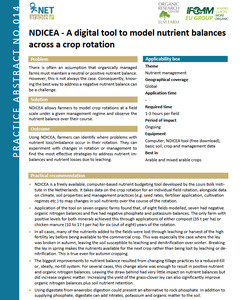{Tool} NDICEA - A digital tool to model nutrient balances across a crop rotation (OK-Net Arable Practice Abstract). Creator(s): Mullender, Samantha. Issuing Organisation(s): ORC - Organic Research Centre. OK-Net Arable Practice abstract, no. 014. (2018)
Preview |
PDF
- Published Version
- English
(NDICEA - A digital tool to model nutrient balances across a crop rotation)
464kB |
![[thumbnail of 2025-01-30 20_27_08-Practice Abstract - PA_014_ORC_NDICEA_final.pdf – Mozilla Firefox.png]](/32609/7.hassmallThumbnailVersion/2025-01-30%2020_27_08-Practice%20Abstract%20-%20PA_014_ORC_NDICEA_final.pdf%20%E2%80%93%20Mozilla%20Firefox.png)  Preview |
Image (PNG)
- Cover Image
- English
100kB |
Document available online at: https://orgprints.org/32609
Summary in the original language of the document
Using NDICEA, farmers can identify where problems with nutrient loss/imbalance occur in their rotation. They can experiment with changes in rotation or management to find the most effective strategies to address nutrient imbalances and nutrient losses due to leaching.
Practical recommendation
• NDICEA is a freely available, computer-based nutrient budgeting tool developed by the Louis Bolk Institute in the Netherlands. It takes data on the crop rotation for an individual field rotation, alongside data on climate, soil properties and management practices (e.g. seed rates, fertiliser application, cultivation regimes etc.) to map changes in soil nutrients over the course of the rotation.
• Application of the tool on seven organic farms found that, of eight fields modelled, seven had negative organic nitrogen balances and five had negative phosphate and potassium balances. The only farm with positive levels for both minerals achieved this through applications of either compost (35 t per ha) or chicken manure (10 to 17 t per ha) for six (out of eight) years of the rotation.
• In all cases, many of the nutrients added to the fields were lost through leaching or harvest of the high fertility ley before being available to the commercial crop. This was especially the case where the ley was broken in autumn, leaving the soil susceptible to leaching and denitrification over winter. Breaking the ley in spring makes the nutrients available for the next crop rather than being lost by leaching or denitrification. This is true even for autumn cropping.
• The biggest improvements to nutrient balance resulted from changing tillage practices to a reduced-till or, ideally, no-till system. For several cases, this change alone was enough to result in positive nutrient and organic nitrogen balances. Leaving the straw behind had very little impact on nutrient balances but did in-crease organic matter. Increasing the yield of the grass-clover ley can also significantly improve organic nitrogen balances plus soil nutrient retention.
• Using digestate from anaerobic digestion could present an alternative to rock phosphate. In addition to supplying phosphate, digestate can add nitrates, potassium and organic matter to the soil.
| EPrint Type: | Practice tool |
|---|---|
| What problem does the tool address?: | There is often an assumption that organically managed farms must maintain a neutral or positive nutrient balance. However, this is not always the case. Consequently, knowing the best way to address a negative nutrient balance can be a challenge. |
| What solution does the tool offer?: | NDICEA allows farmers to model crop rotations at a field scale under a given management regime and observe the nutrient balance over their course. |
| Country: | United Kingdom of Great Britain and Northern Ireland |
| Type of Practice Tool: | Practice abstracts |
| Theme: | Nutrient management |
| Keywords: | diagnostic tool, nutrient management |
| Keywords: | measuring instruments, nutrient management, monitoring and evaluation, crop rotation, farm management, digital technology |
| Agrovoc keywords: | Language Value URI English arable farming http://aims.fao.org/aos/agrovoc/c_36528 English nutrient management http://aims.fao.org/aos/agrovoc/c_330697 English measuring instruments http://aims.fao.org/aos/agrovoc/c_12457 English monitoring and evaluation http://aims.fao.org/aos/agrovoc/c_bea12d1e English crop rotation http://aims.fao.org/aos/agrovoc/c_6662 English farm management http://aims.fao.org/aos/agrovoc/c_2799 English digital technology http://aims.fao.org/aos/agrovoc/c_4b2d7f85 |
| Subjects: | Farming Systems > Farm nutrient management |
| Research affiliation: | European Union > Horizon 2020 > OK-Net Arable > OK-Net-Arable Tools European Union > Horizon 2020 > OK-Net Arable International Organizations > International Federation of Organic Agriculture Movements IFOAM > IFOAM Organics Europe UK > Organic Research Centre (ORC) European Union > Organic Farm Knowledge |
| Horizon Europe or H2020 Grant Agreement Number: | 652654 |
| Related Links: | https://organic-farmknowledge.org/tool/32609, http://www.ndicea.nl/ |
| Project ID: | ofk |
| Deposited By: | Basler, Andreas |
| ID Code: | 32609 |
| Deposited On: | 01 Feb 2018 13:24 |
| Last Modified: | 30 Jan 2025 19:28 |
| Document Language: | English |
| Status: | Published |
Repository Staff Only: item control page


